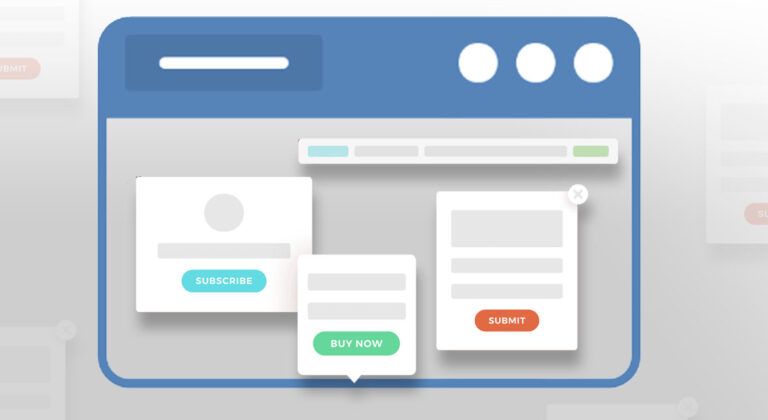What is Lead Nurturing: 11 Best Practices and Tactics (2025)

I hope you enjoy this blog post. If you want Hello Bar to grow your leads, click here.
Author:
Ryan Bettencourt
Published
July 16, 2024
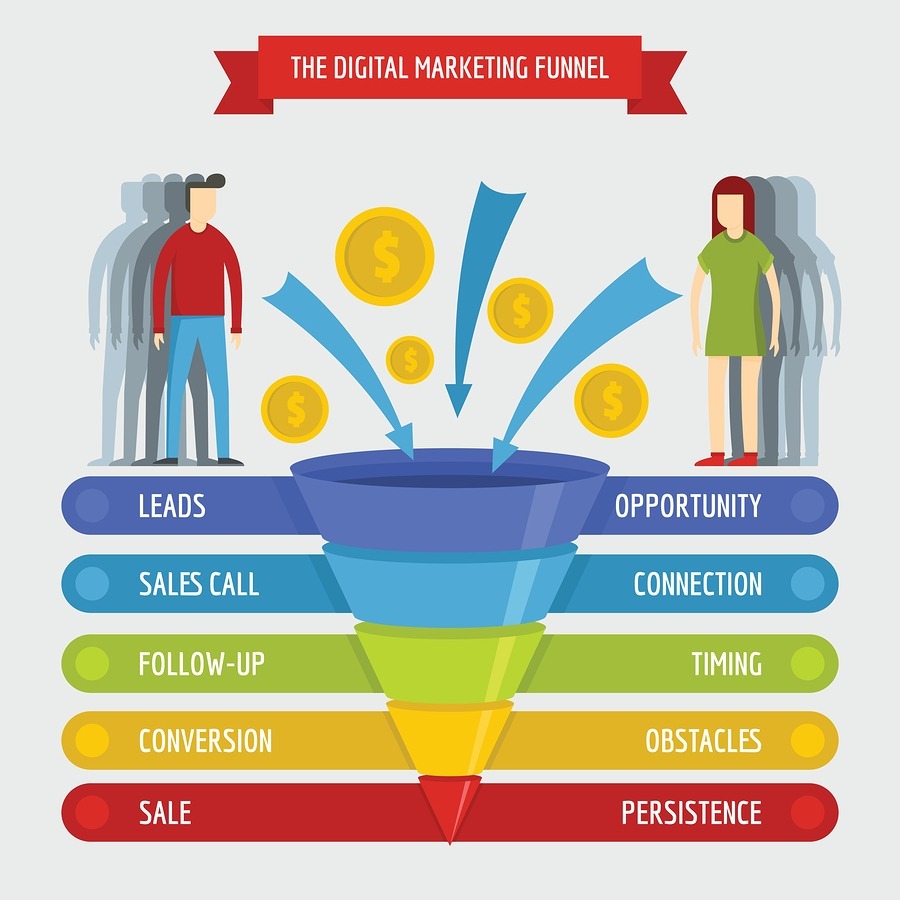
Lead nurturing is one of the only ways to expand your sales funnel and keep buyers moving through it. These days, consumers need a little hand-holding before they’ll part with their cash.
But what is lead nurturing? And what does it look like in action?
Marketing has become littered with buzzwords that even marketers sometimes don’t fully understand. It’s hard to keep up.
For instance, you need to know the difference between lead capture, lead nurturing, and lead acquisition.
That’s why we’ve created this primer on lead nurturing. Use it to usher your prospects through the buyer’s journey, answer their questions, overcome their objections, and prove your superiority over your competitors.
What Is a Lead? And How Do You Get Leads?

A lead is someone who has given you their contact information so you can get in touch at a later date for marketing. That’s a mouthful, right?
It’s pretty simple, though. They’re your future customers.
If you’re attending a trade show, you might converse with a prospective customer. You might say, “Hey, do you have a card? We could call you later next week so we can discuss this further.”
If the prospect hands over a business card, you’ve just won a lead.
But what does this same process look like in terms of digital marketing?
You can still collect phone numbers, especially if you run a business that is highly driven by a sales team. However, most marketers these days are more interested in getting email addresses.
An email is easier to stomach than a phone call. There’s no reason for either party to think quickly on their feet, and you can automate your marketing processes to reduce manual labor.
Let’s say a prospect finds your website using Google search. They read the page and find themselves interested in your copy. Then they see a signup option, such as a top bar.

The prospect wants your free tips and advice, so they type in their email addresses and click “I Want In!” Now you have yourself a lead.
It sounds simple enough, but you’re competing against a lot of other people in your niche for email addresses. Plus, getting the lead is just the beginning.
Once you have a lead, you have to nurture it.
What Is Lead Nurturing?

Lead nurturing is the process of helping your leads make a buying decision. Ultimately, you want those leads to choose your products or services instead of someone else’s.
Lead nurturing provides your leads with what they want, need, or expect — and sometimes all three. You have to time your messaging correctly, too, so you don’t rush the sale.
Think about your own consumerism. How do you make buying decisions?
It likely depends on what you want to buy. The more expensive or complex the product, the more time you spend evaluating your options.
You might visit websites to figure out who offers the type of product you need. Then, you might read online reviews, ask your friends and family members for recommendations, check out social media, and visit individual product sales pages.
Some buying decisions start even earlier. If you don’t know anything about a product, you first need to figure out what it does. You might want to read a comparison of different products in the space.
Throughout this time, companies will attempt to capture your contact information and nurture you as a prospective customer. You’ll do the same for your leads.
What Is a Lead Nurturing Campaign?
During a lead nurturing campaign, you send your leads a series of messages designed to build up to the sale. In most cases, this means using email drip campaigns.
A drip campaign is automated, so you don’t have to manually send messages over and over again. Each email in the drip campaign gets sent out to your leads at regular intervals so your leads become more brand-aware and comfortable with hearing from you.
But here’s the kicker:
If your lead nurturing campaign offers nothing of value, your leads will disappear.
That’s a hard truth to hear, but it’s best to get it out of the way. Consumers are inundated with emails these days, and promotional, salesy messages will get deleted.
Worse, your leads won’t even open subsequent emails. They’ll send them directly to the spam or trash folder.
So how do you add value to your lead nurturing campaign?
- Direct your leads to in-depth content you’ve created, such as blog posts, videos, and podcasts.
- Offer a discount on your most popular product.
- Provide email subscription-only benefits, such as free shipping codes.
- Share personal anecdotes to which your leads might relate.
- Explain how you overcame a problem that your leads likely have, as well.
For instance, City Beauty provides helpful tips about skincare and suggests products to solve specific beauty problems. This lead nurturing helps make the reader feel understood and excited about upcoming sales, encouraging them to keep an eye out for more emails and eventually buy the products.
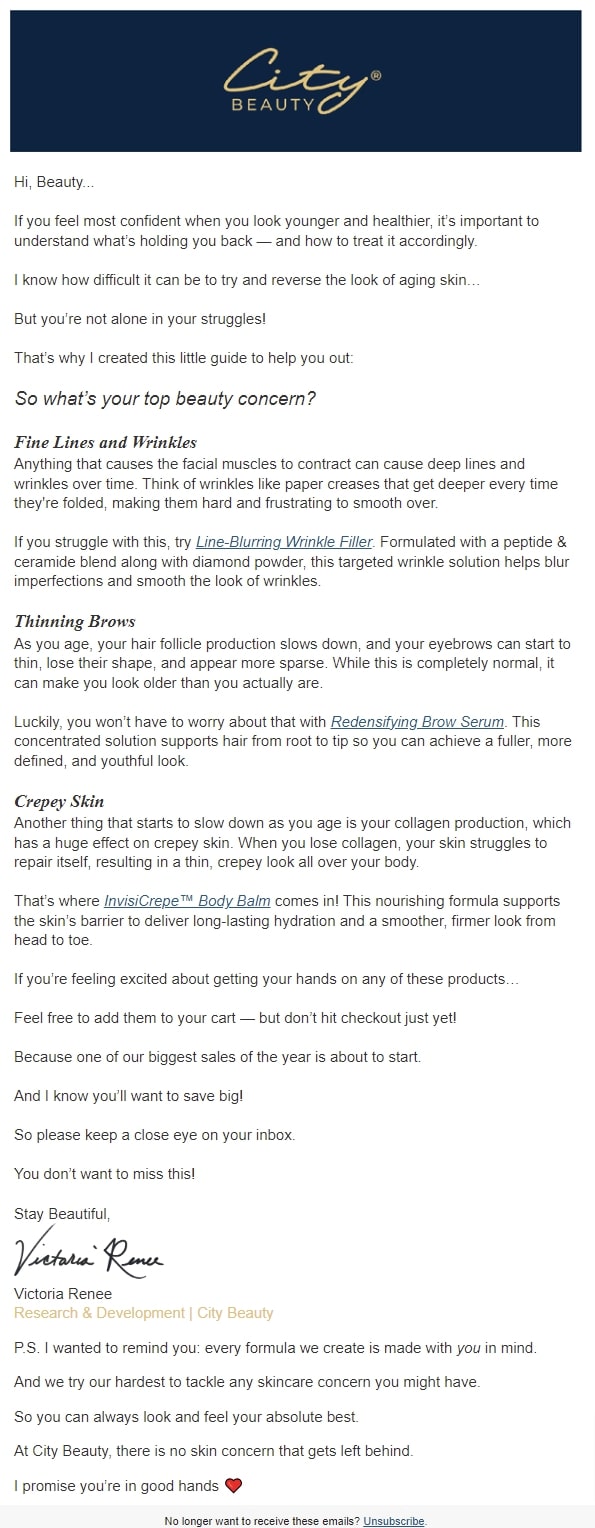
Image via Milled
There are plenty of other ways to generate significant value for your leads. Before you send out an email, ask yourself one important question:
“Who does this email benefit more: me or my leads?”
If the answer is you, take it in a different direction. Yes, you want your leads to buy from you, but they’ll only do so if you nurture them with generously provided value.
What Is Email Marketing Automation?
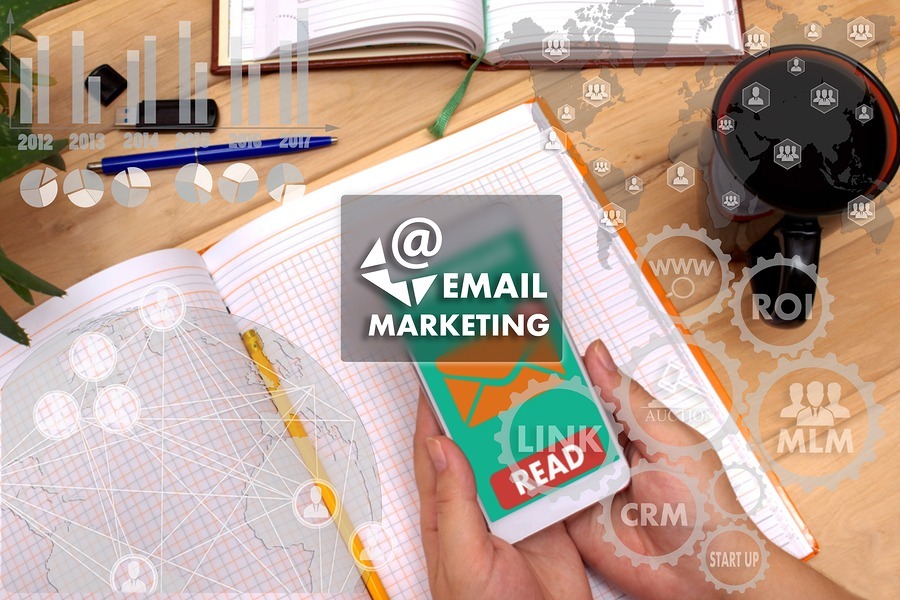
We touched on email marketing automation earlier, but let me explain it further.
You can build your email list as much as you want. Many people have hundreds of thousands of subscribers.
Most marketers don’t have time to write to each subscriber individually. That would be a huge waste of time. Furthermore, they don’t have time to manually send emails at the right time and on the right day.
That’s where email marketing automation comes in.
You write the email and upload it to your email marketing provider. You then decide which email list the email should be sent to, schedule the time of sending, and move on to something else. It’s that simple.
You can automate email drip campaigns or single emails, depending on the purpose of the message. Additionally, consider segmenting your email subscribers so you’re sending the right emails to the right people.
What Is Lead Scoring?
Lead scoring allows you to give each lead in your database a ranking based on his or her potential value to your business. That sounds a little cold, but it’s highly effective.
A lead who scores low either isn’t ready to buy or doesn’t have the means to buy. Leads who score highly have a greater chance of not only buying from you, but remaining a loyal customer and making subsequent purchases.
You can use several different types of information in lead scoring for instance:
- +2 points for commenting on a social media post
- +6 points for clicking a link in an email
- +12 points for downloading a whitepaper
- +20 points for signing up for a free trial
- -15 points for marking an email as spam
Your lead nurturing activities become far more effective when you score leads because you know where to focus most of your time. Is it always accurate? Of course not. However, it gives you a baseline from which to begin each marketing campaign.
You might have an email list for your top-scoring leads. Customers on this list might receive discount codes, coupons, offers for free shipping, buy-one-get-one-free deals, or other incentives to buy right away.
Leads who score lower on the scale aren’t ready to buy. You can market to them by sending educational information, comparison guides, and links to your best content.
11 Best Practices and Tactics to Create Effective Lead Nurturing Process Campaigns
With these essential terms defined, it’s time to get into the nitty-gritty of lead nurturing. The more you understand this process on a fundamental level, the more capable you become of leveraging it.
The lead nurturing process requires some tweaking as you collect data. Let’s look at the strategies you can follow to make lead nurturing a success for your business.
1. Be Personal When Nurturing Your Leads

Personalization can have tremendous benefits for any lead nurturing strategy. In fact, 96% of marketers believe that personalizing messages makes customers more likely to come back, and 94% say it helps sell more products.
Think about it in terms of human connection.
When you’re bonding with another person, you share details about your lives, call each other by name, and empathize with one another’s plights.
The best marketing copy does the same thing. Just because you’re talking to lots of people doesn’t mean you can’t make each particular lead feel like they’re the only one on your email list.
Write in conversational prose and use informal greetings. Share information about your own life, struggles, goals, and achievements.
This email is a great example of personalization because it uses the person’s name and thanks them for signing up. It’s a great way to nurture leads by making them feel special and giving them useful information right away.
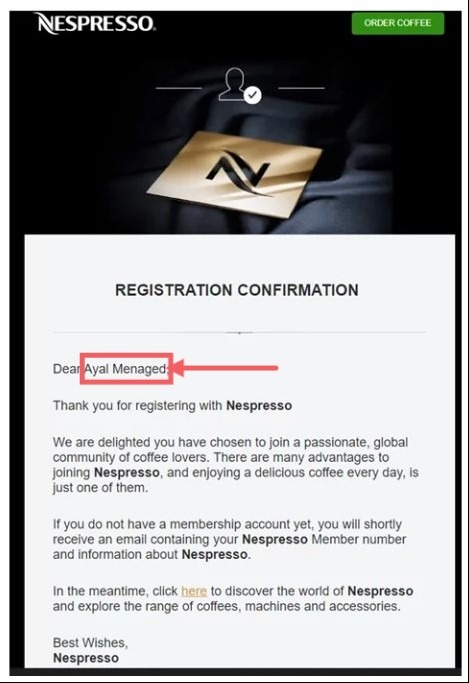
Image via Segmentify
Add Your Lead’s Name at the Top of Your Nurturing Emails
Forget Shakespeare and his legendary rose. People like to hear (and read) their own names.
When you address your leads by name, you show you care about them. The email feels like it comes from a friend rather than a marketer or company.
You can use names in your email subject lines as well as the body copy. You don’t have to use it over and over — that gets a little gimmicky — but once or twice won’t hurt.
Use Details About Your Lead’s Lifestyle, Location, Company, and Activities
Modern email service providers can help you personalize your emails even further. For instance, if you’re marketing to a B2B lead, you could include the company’s name and the business’s URL.
Using the lead’s geographical location can also help. Saying something like, “What would be the best [product] for you over there in Las Vegas, Nevada?” might prove effective. You’d want to tweak the wording to match your brand messaging.
Lifestyle and activities are other ways to personalize emails. If you know your lead signed up for your list from a page on sporting goods, you know he or she is active. Mention active lifestyles, exercising, and other relevant and contextual information.
2. Do Not Spam Your Leads
There’s no general consensus in the marketing world about how often you should email your leads. Once a week, though, is typically accepted as a reasonable interval between emails.
We once gave my email address to an e-commerce store that sells men’s hiking gear. It was a huge mistake. We heard from the company at least twice a day, and always with emails that had subject lines like, “Get your hiking boots today!”
Needless to say, we unsubscribed. And we never spent a dime on that company.
3. Use Your Lead Nurturing Emails to Educate Your Leads During the Buyer’s Journey
Education is underrated. We live in a thriving DIY culture in which most people conduct hundreds or even thousands of Google searches weekly.
We’re thirsty for information because we don’t want to buy the wrong product or spend money unnecessarily. We also enjoy the sense of accomplishment that comes from learning.
If you’re willing to share your knowledge freely with your audience, you’ll gain tremendous respect. Plus, it’s a great way to nurture your leads through the buyer’s journey.
Though there are several models from which to work, we recommend focusing on the three main phases of the buying process: awareness, consideration, and decision.
Awareness Phase
The awareness stage is when your buyer first becomes aware of your company. They have realized he has a problem to solve or a goal to reach, so they go to the Internet to figure out the solution.
Google searches might lead your prospect to your website. He pokes around, reads your articles, and sees your signup form.

Boom! You have a lead.
At this stage, the customer isn’t ready to buy. They’re looking for information.
Your emails to this segment of your email list might include links to your blog articles, special advice sent via email, and other educational information. Target beginners or people who don’t have much knowledge about your industry in this phase.
Consideration Phase
The next phase is consideration. The buyer has realized they have a problem or goal and have discovered that there are multiple potential solutions. Your product or service is one of them.
Comparison is the name of the game at this stage. You want to position your product or service as superior to others, so send emails that not only mention the competition, but show how you come out on top.
This is also the time to send educational emails that target a more aware audience. They’re familiar with the options on the market, but they might not understand the granular details required to make a decision. Help them.
Decision Phase
Now we come down to the wire. Your prospect has recognized a problem or goal, discovered multiple solutions, and reached a decision. You just have to provide the tipping point.
Nurturing leads at this stage is all about the sale. What will incentivize your prospect to buy now?
Discounts and free shipping codes work great during the decision phase. It’s also called the conversion phase. You want your prospect to stop thinking and comparing and make a purchase.
4. Start Your Lead Nurturing Process Campaign as Soon as Possible

These days, delayed gratification has become endangered. Consumers want things now — if not sooner.
They also expect to hear from brands quickly. While you don’t want to spam your customers, you do want to get in touch quickly. Sending out an email the moment someone subscribes can have a huge impact on your relationship with that lead.
Your welcome email should be all sunshine and light. Thank the lead for signing up for your email list, provide a preview of what’s to come, and set the lead’s expectations, just like Baltic Born here.
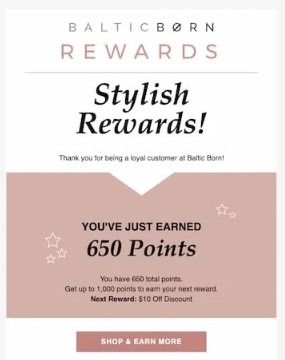
Image via HubSpot
5. Segment Your List to Target Specific Groups at a Time
We talked about the awareness, consideration, and decision phases above. As we pointed out, consumers in these phases have different needs.
Segmenting your email list can help you nurture leads at the right time — and with the right message. If you send out a hard-sell email with a discount code to someone who doesn’t even know what your product does, that lead will probably tune you out.
Depending on your business, you might want to segment even further. For instance, you might have two different products that target different buyer personas. Having separate email lists, further segmented by position in the buyer’s cycle, can help you send more targeted messages.
This lead nurturing strategy can help you achieve more leads and lead nurturing success. Using segmentation to deliver personalized content is a great way to convert leads into high-quality leads and ensure a successful lead nurturing process.
6. Find Out What Your Leads Pain Points Are and Create Awesome Content About It
Everyone has pain points. It sounds like a negative thing, but it’s actually just a part of life.
Think about a business that doesn’t have an effective communication channel for internal collaboration. That’s a pain point. It can be solved with a product like Slack, Asana, or Asana alternatives.
Your leads’ pain points are related specifically to your product. How does your product make life easier for customers? How does it enrich their lives, give them more opportunities, free up time, or entertain them?
Don’t discredit boredom as a pain point. There’s a reason Netflix thrives.
Once you identify specific pain points, address them in content. How-to articles work well for this purpose. So do listicles (articles with lists of strategies, tools or other items).
Link to that content in your emails to leads. Show them that you’re willing to give generously and that they can count on you to help them.
7. Do Not Rely 100% on Email to Nurture Your Leads – Use Multi-Channel Lead Nurturing
Email marketing is a great way to nurture leads. It’s no wonder 87% of brands say that email marketing is very important for their business success.
You get to communicate directly with people who might become customers.
However, it shouldn’t be your sole focus when it comes to lead nurturing. A multi-channel approach works far more effectively.
Other channels through which to nurture your leads include:
- Social media
- Blog posts
- YouTube videos
- Podcasts
- Webinars
Each of these channels provides you with access to a new audience. People who never read blog posts might instead watch your videos. Those who disdain social media could discover your text content.
The idea is to grab attention wherever you can. Nurture leads by providing insanely valuable content. They’ll keep coming back for more once you prove you can deliver.
8. Measure How Interested Your Leads Are in Your Products
No form of lead nurturing will result in sales if your leads don’t care about your products. That’s the bottom line.
This isn’t a problem only small companies face. Consider the failure of Google Glass. One of the most successful businesses in the world invested billions of dollars in a product that ultimately failed to attract buyers.
It wasn’t because the company lacked an effective landing page. It was because Google Glass didn’t have a crystal-clear function, it didn’t look appealing, and it seemed more like a prototype than a finished product.
If you’re having trouble at the product stage, you need to go back to square one.
You also have to consider whether you’re targeting the right leads. In other words, are your subscribers actually members of your target audience?
Let’s look at a few ways to measure your leads’ interest in your products.
Email Analytics – How Well Are Your Leads Responding to Your Emails?
Start by checking out your email stats. Metrics like open and click-through rates will tell a solid story.
If nobody’s opening your emails, the problem might revolve around your email subject lines. Tweaking them can help boost your open rates.
However, low click-through rates either relate to a problem with the email messaging or a problem with the product and its audience. Consider polling people in your emails to find out why they’re not clicking with your content.
Social Media – How Well Are Your Leads Engaging With Your Social Media Posts?
Social media can tell an even more enlightening story. You’ll learn whether you’re failing to reach the right people with your product — or whether your product isn’t quite right for your company.
When people find great products, they love to talk about them on social media platforms through Instagram comments, Facebook messages, or Twitter posts. They also engage with brands on social to share user-generated content, compliments, questions, and requests for future features.
Low engagement on social means you’re either using a poor social strategy or that your leads aren’t really interested in your product. Track brand mentions, product mentions, branded hashtag usage, likes, retweets, shares, and comments, among other metrics, to figure out how well you’re doing in the social space.
Website Analytics – Do Your Leads Visit Your Website’s Valuable Pages?
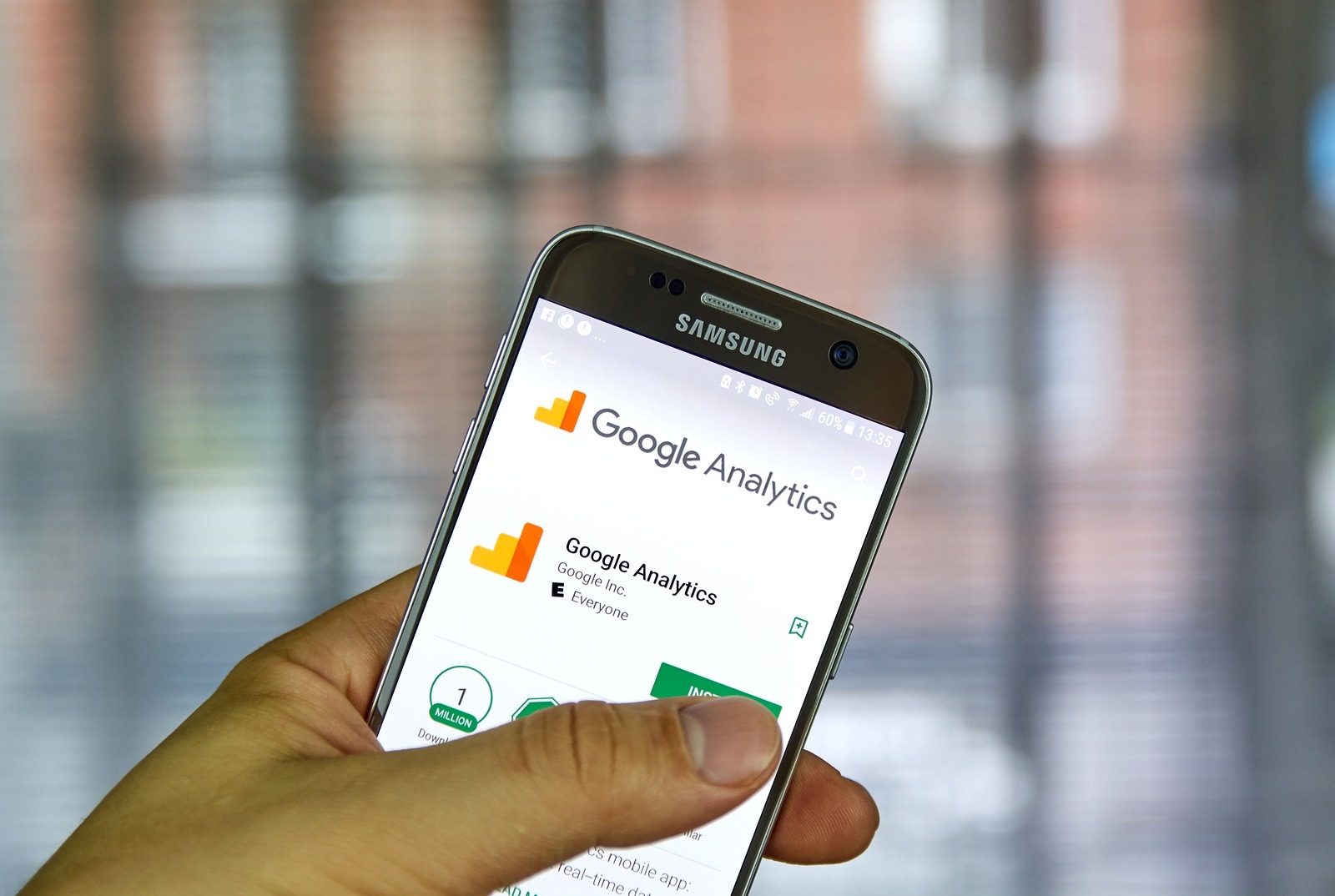
Google Analytics can help you understand your website’s total health. Follow your visitors as they click on internal pages, bounce away from the site, or follow internal links.
More specifically, focus on product and landing pages. Do your website visitors do anything? If they’re not signing up for your email list, buying your products, or otherwise engaging with your brand, there’s a problem.
9. Determine If Your Leads Are a Fit for Your Brand or Product
Your target audience has to be a good fit for whatever you’re selling. Each audience member must also resonate with your brand.
For instance, GoPro sells camera gear. That’s its basic business model. However, it specifically targets people who want to record action-oriented experiences. Its target audience consists of athletes, adrenaline junkies, and people who enjoy traveling.
Nikon and Canon also sell camera gear. Their target audience is much wider, however, with many of their customers falling into the category of professional photographers.
GoPro’s lead nurturing strategy wouldn’t work if it started to attract people who want to take portraits of family and friends. That’s not their target audience.
Lead Demographics
Demographics consist of qualities of individual consumers, such as geographic location, age, gender, income bracket, interests, and job titles. You can glean this information from numerous sources, but first you need to know what demographics best fit with your products.
Let’s go back to the GoPro example. One buyer persona for GoPro might feature the following demographics:
- Male
- Ages 20-40
- Income $40,000/year minimum
- Bachelor’s degree or higher
- Single
- Middle management or below
That’s just one persona. Others could include females, different age ranges, higher or lower income levels, married professionals, or CEOs. However, GoPro would have to find a reason to include those demographics among its target audience.
Lead Firmographics
Think of firmographics as demographics for businesses. When you’re in the B2B industry, you don’t get to ignore this type of information.
If you’re selling SaaS software, one of your buyer personas might look like this:
- Vice President of Marketing
- Male
- Age 40-50
- MBA graduate
- Expert in digital marketing
A fully fleshed-out buyer persona will contain more information, but you get the picture.
Figure out what type of business would best fit with your product. For instance, you would target SMBs differently than you would enterprise-level companies.
Lead BANT (Budget, Authority, Need, and Time)

The BANT acronym stands for budget, authority, need, and time. They’re great benchmarks from which to begin your lead nurturing efforts based on lead qualification.
Use BANT to figure out whether or not a lead has the potential to become a customer.
- What budget does the lead have for your product or service?
- Does your lead have the authority to make purchasing decisions for the household or business?
- How badly does your lead need your product or service?
- How much time will the lead take to make a decision?
Based on the answers to these questions, you can ramp up or scale down your marketing efforts for a particular segment of your target audience.
10. Automate Your Lead Nurturing Email Campaigns
We can’t stress the importance of automation enough. Lead nurturing email campaigns can be highly successful, but you must make good use of your time.
Automation is a key element of any effective lead nurturing strategy and helps streamline your lead nurturing efforts.
If you set up an email drip campaign now, you could use the same one for the next year, making just small changes as your business evolves. That saves a ton of time and effort.
There’s no reason to keep recreating the same thing. Similarly, you shouldn’t have to hit a button every time you want an email to go out to a specific list.
Software like RightInbox will allow you to automate your outbound sales campaigns from your inbox and schedule the time of sending.
Automating this process is crucial to increase conversion rates for mass reach out. It’ll ensure your lead nurturing campaigns are consistent and effective.
What Is Behavior-Based Email Marketing Automation?
Behavior-based email marketing automation refers to an email system in which delivery is triggered by specific user behavior. For instance, the lead signs up for your email list and automatically receives a welcome message.
Thank-you emails might be triggered by purchases, abandoned cart emails can be triggered when a lead leaves your site with items in their cart, and reconnection emails work well with dormant subscribers.
By using behavior-based email marketing automation, you can customize your lead nurturing process to fit each lead’s needs. This makes your lead nurturing program more effective and efficient.
11. Create Nurturing Campaigns to Re-Engage Your Leads When Necessary
Speaking of reconnection, nurturing doesn’t always refer to the beginning of a relationship. It’s like when you haven’t talked to a friend in a few months. You realize you’ve let your friendship founder, so you give them a call to catch up.
It’s the same deal with lead nurturing strategies. Send an email to dormant subscribers to ask if they still want to hear from you. Mention any new incentives that might encourage them to respond positively, then offer a discount or other item of value as an act of generosity.
For example, LingQ sent a cheerful email to past users saying, “We Miss You!” and offered a 10% discount on all Premium plans to make their return exciting. This type of message can delight and re-engage your nurtured leads.
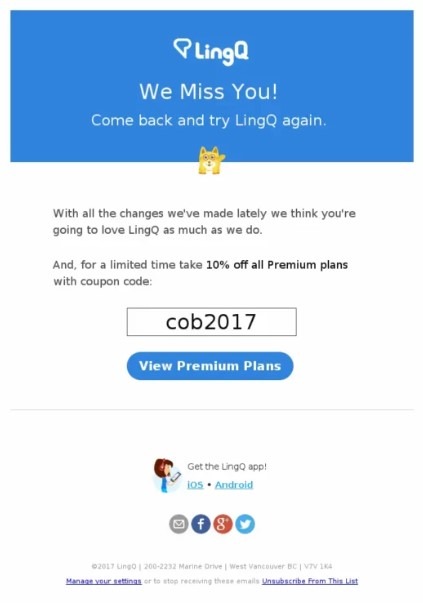
Image via GetResponse
This type of email can work wonders when your existing leads have forgotten you exist. Remind them what they loved about your business or product in the first place.
How to Use Lead Scoring to Greatly Improve Your Lead Nurturing Results

Lead scoring is all about criteria. You want to know the minimum criteria for a lead to become valid as a potential customer.
For instance, if your product costs $2,000, and your lead is only willing to spend $1,000, you’re at an impasse. Unless the customer suddenly decides to double his budget, that person will probably never become a customer.
Budget is just the starting point. Go back to the BANT analysis and figure out where the customer falls in the buying cycle. For instance, if the lead is still in the awareness stage, he or she is probably going to spend more time evaluating his or her options.
Similarly, when you’re marketing to a B2B business, you don’t want to waste time on a lead who doesn’t have the authority to make buying decisions. You can ask to be introduced to the decision-maker, but spending time nurturing that lead probably won’t yield positive results.
How to Determine Your Lead Score
Your lead scoring efforts should create a baseline for lead nurturing based on the confluence of three qualities: ready, able, and willing.
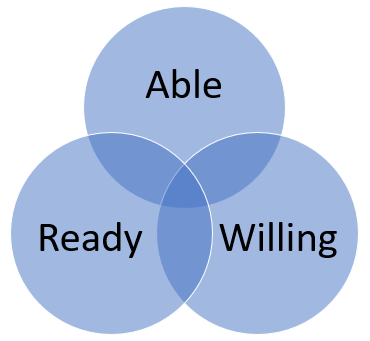
It’s at this confluence that a lead becomes a likely candidate for buying your product or service.
You’ll notice that the venn diagram includes multiple intersections, right? These represent different stages of the buyer’s journey. At specific intersections, you can nurture these leads with different types of content.
If a lead is able and willing, but not ready, you might create some urgency. Send a limited-time offer for a discount, free shipping, or a free demo.
Similarly, if a lead is ready and willing, but unable, send educational content to prepare that lead for the point at which he becomes able.
Your lead’s score should be based on a specific scale, such as 1-10. Each number should describe your lead’s position in the buyer’s journey.
FAQs
Q1. What does lead nurturing mean?
Lead nurturing is the process of building meaningful relationships with potential customers throughout their buyer’s journey. You engage with them through relevant and valuable content, address their needs, and guide them through the consideration stage of the sales funnel. With good lead nurturing, you can convert leads into sales-ready customers by giving them the right info and solving their problems.
Q2. What is an example of a lead nurturing strategy?
An example of a lead nurturing strategy is using an email marketing campaign to engage with your leads. You can send personalized emails containing educational content, product updates, valuable insights, and exclusive offers to potential customers interested in your offerings.
Q3. What is a lead nurturing strategy?
It means planning activities to connect with your leads and build meaningful relationships over time. You can use emails, social media, and content marketing to share valuable content, help them through the sales cycle, and turn them into loyal customers.
Q4. What is the difference between lead scoring and lead nurturing?
- Lead Scoring: Giving points to leads based on what they do, like visiting your website, downloading content, or opening emails. It helps you decide which leads are most likely to become paying customers.
- Lead Nurturing: Engaging with leads through personalized and relevant content to build relationships and guide them through the buyer’s journey. It provides value and addresses leads’ needs to move them toward a purchase.
Q5. What are the key elements of a lead nurturing strategy?
An effective lead nurturing strategy involves several key elements:
- Prioritizes leads based on their engagement and potential to convert.
- Uses lead nurturing tools to automate repetitive tasks and send timely, relevant content.
- Relevant and valuable content to address your leads’ pain points and guide them through the buyer’s journey.
- Align sales and marketing teams to optimize the lead nurturing program.
- Use multiple channels like email, social media, content marketing, and webinars to reach and engage leads.
- Create content that fits the specific needs and interests of each lead.
- Track how well your nurturing campaigns are working.
Conclusion
We love lead nurturing because it presents challenges while keeping marketing fun and exciting. We get to communicate with potential customers who will benefit from whatever we’re selling, and we get to come up with creative ways to express that.
You’ll learn to love lead nurturing, too, if you follow the guide above. Focus on giving the customer what he or she needs at the exact right time.
It takes practice, but you’ll get it right.
How do you approach lead nurturing?



